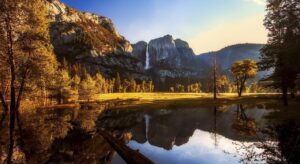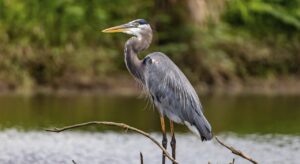Hawaii Volcanoes National Park is the only one of its kind in the United States, located a considerable distance from the mainland.
The park contains two active volcanoes, Kilauea and Mauna Loa.
Kilauea is the most active volcano in the world and the youngest of Hawaii’s land volcanoes: only about 300-600 thousand years old. Its restless nature, the impulsiveness caused by the incessant movement of magma, is also indicated by its local Hawaiian name: “ki-lau-za” means “spewing.” It has a gentle, which is typical of Hawaiian volcanoes, somewhat convex shield-shaped cone, composed of basaltic lava. The cone ends in a vast caldera – a depression, like a man-made pit, more than 200 m deep, at the bottom of which is a lava lake Halemaumau-mau (Halemaumau). The lake boils and splashes, throwing out fountains of red-hot drops that can burn through metal and stone.
From below, from the bowels of the earth, such a gigantic force presses that one lake is not enough to release lava, and along the West and Southeast Rift zones that diverge from the top of Kilauea, there are dozens of small craters and two cones – Puu Oo and Kupayanaha – from which lava also flows out.
Not surprisingly, Kilauea’s recent history is steeped in legend. Hawaiians believe it is the palace of Pele, the goddess of fire, lightning, and volcanoes. They have named lava flows after her: Pele’s Tears – air-cooled lava particles in the form of droplets; Pele’s Hair – lava spray that burst out of the volcano and froze in the wind; Pele’s Algae – cooled and burst during the lava flow into the ocean of lava bubbles.
Another volcano, Mauna Loa, is the second largest in the world by volume and height (if you count the underwater part) and occupies a good half of the island of Hawaii. It also has a flat top, and a noticeably elongated shape, which is reflected in the Hawaiian name of the volcano, which translates to “long mountain.” The volcano is active, there are frequent eruptions – every 3-4 years. What sets it apart from other volcanoes on the islands is that its summit is often covered with snow in winter.
The founders of the park had two goals: first, to provide an environment for scientists studying the history of Hawaii and the processes of volcanism, and second, to satisfy the curiosity of all those who want to enjoy the spectacle of a striking volcanic landscape, as well as to see the local flora and fauna in the wild.
Scientists work in a specially created volcanological station as well as a geophysical observatory, the first permanent observatory of its kind in the United States, opened back in 1912.
The routes for tourists are safe: in the past, it was not uncommon for careless and presumptuous travelers to remain here forever, dying in the streams of red-hot lava.
The Hawaiians who live around volcanoes have developed a special rhythm of life depending on the eruptions. The soil around volcanoes is very fertile, but when they erupt, they release tephra (volcanic ash) that hangs in the air and is dangerous to life. It later falls as acid rain. During this time, the islanders stay away from the volcanoes, for example, by fishing. The situation rather quickly recovers, and people return to their usual activities, cultivating the soil near the volcanoes.
But there are areas where it is impossible to live at all, like the wild desert of Kau, covered entirely with hardened lava, sand and gravel, irrigated by acid rain. The local landmark, the footprints in the ash of the Kau Desert, were left, according to Hawaiian legends, after the eruption of 1790. It was the year that Chief Kauhuula and his warriors crossed the desert after defeating Chief Kamehameha, and eighty of his warriors suffocated because of the tephra.
The island of Hawaii lies nearly 4,000 km from the nearest mainland (North America). A unique fauna and flora has formed here, which is constantly threatened by the neighborhood of volcanoes. Immediately around the volcanoes no life at all, vegetation – rainforests – appears at the foot and is represented by the tree fern Cibotium, tenacious shrub Freysinetia and small trees Psychotria mariniana. There are almost no terrestrial animals (the most common is the bissa tortoise), but many birds, including such colorful ones as the firebird and the black-and-white Hawaiian florcher.
The closest town to the park is Port Hilo, the largest on the island of Hawaii and second only to the state capital, Honolulu. The city has long been accustomed to the close proximity of the active Mauna Loa volcano, but it is frightened by something far more dangerous. The fact is that it is located on the shore of the bay of the same name, which has the notoriety of the “all-American tsunami capital”: tsunamis from South American Chile and the northern Aleutian Islands reach here across the Pacific Ocean, sometimes taking the lives of dozens of Hilo residents.


